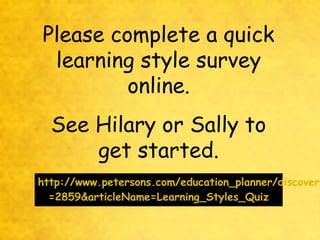
Learning styles 32009
- 1. Please complete a quick learning style survey online. See Hilary or Sally to get started. http://www.petersons.com/education_planner/discoveri =2859&articleName=Learning_Styles_Quiz
- 2. Learning Styles Lunch and Learn Davis Elementary March 24, 2009 Sally Dwelle and Hilary Williams
- 3. What are different learning styles? How does my child learn best? How can I help my child use his or her learning style to maximize learning potential?
- 4. What is Differentiation? Differentiation can be defined as a way of teaching in which teachers proactively modify curriculum, teaching methods, resources, learning activities, and student products to address the needs of individual students and/or small groups of students to maximize the learning opportunity for each student in the classroom. Tomlinson, C.,At Work in the Differentiated Classroom, 103.
- 5. Differentiated Instruction: The Big Picture 3 Curricular Elements • Content 3 Student Characteristics • Readiness level • Process • Interest level • Product • Learning profile – What students should know – What students should understand – What students should be able to do – Skills and understanding of a topic – Tasks that ignite student curiosity or passion – Preferred learning style of each student
- 6. What are Learning Styles? Learning Styles are simply different approaches or ways of learning.
- 7. What are the types of Learning Styles? • Visual • Auditory • Kinesthetic/Tactile
- 8. Auditory Learners learn through listening… • Verbal lectures, discussions, talking things through • To tone of voice, pitch, speed and other nuances. • So written information may have little meaning until it is heard. These learners often benefit from reading text aloud and using a tape recorder.
- 10. Visual Learners learn through seeing… • Need to see the teacher's body language and facial expression. • Tend to prefer sitting at the front of the classroom • May think in pictures and learn best from visual displays • Prefer to take detailed notes during lecture or classroom discussion to absorb the information.
- 12. Kinesthetic/Tactile Learners learn through moving, doing, and touching… •Tactile/Kinesthetic persons learn best through a hands-on approach, actively exploring the physical world around them. •They may find it hard to sit still for long periods and may become distracted by their need for activity and exploration.
- 14. Sorting Activity
- 17. What is Multiple Intelligence? Different ways to demonstrate intellectual ability.
- 18. What are the types of Multiple Intelligence? Linguistic intelligence ("word smart") Logical-mathematical intelligence ("number/reasoning smart") Spatial intelligence ("picture smart") Bodily-Kinesthetic intelligence smart") ("body
- 19. Musical intelligence ("music smart") Interpersonal intelligence ("people smart") Intrapersonal intelligence ("self smart") Naturalist intelligence ("nature smart")
- 22. Multiple Intelligences Lesson Plans “Choosies” Subject: Energy GPS: Students will identify sources energy and how energy is used BK What Am I? Create an energy riddle using a flip book: 1. Decide the type of energy (heat, light, motion) and the source. 2. Write 3 to 4 clues about your energy source. 3. Draw a picture and answer your riddle on the last page. INTRA VL LM VS Create a nonfiction book about energy. Make sure to include a table of contents and page numbers. You can also choose to include a glossary. Create a machine that uses solar energy to work. Draw a picture of your machine, label the parts, and write 3 to 5 sentences about how your machine works. Create a marble painting. Write a story about a day in the life of a marble. N INTER What would it be like if you had to live without electricity? What other sources of energy would you have to use? Create a poster on ways to save energy. With a partner, create a tree map of man-made and natural sources of energy. M Create an acrostic using the letters in the word ENERGY Draw a picture of you using other sources of energy. List the sources of energy you used on the back of your paper. E N E R G Y BK- Bodily Kinesthetic, VL- Verbal Linguistic, LM- Logical Mathematical, VS- Visual Spatial, INTRA- Intrapersonal, N- Naturalist, INTER- Interpersonal, M- Musical Rhythmic
- 23. BK What Am I? Create an energy riddle using a flip book: 1. Decide the type of energy (heat, light, motion) and the source. 2. Write 3 to 4 clues about your energy source. 3. Draw a picture and answer your riddle on the last page.
- 24. VL Create a non-fiction book about energy. Make sure to include a table of contents and page numbers. You can also choose to include a glossary.
- 25. LM Create a machine that uses solar energy to work. Draw a picture of your machine, label the parts, and write 3 to 5 sentences about how your machine works.
- 26. VS Create a marble painting. Write a story about a day in the life of a marble.
- 27. INTRA What would it be like if you had to live without electricity? What other sources of energy would you have to use? Draw a picture of you using other sources of energy. List the sources of energy you used on the back of your paper.
- 28. N Create a poster on ways to save energy.
- 29. INTER With a partner, create a tree map of man-made and natural sources of energy.
- 30. M Create an acrostic using the letters in the word ENERGY E N E R G Y
- 32. Thinking Points… For which learning style(s) did our presentation today appeal? Explain your answer. How can you help your child use his or her learning style(s) to maximize learning potential? And to sum it up…
Notes de l'éditeur
- This is the lady talking about your child..without the part at the end about teachers.
- This is the MI music one
